Ever since I got into photography a little over 10 years ago, I’ve been fascinated with textures and patterns. While they don’t represent anything per se (at least most of the time), there’s something that draws me into these near abstract shots, but I’ve never quite managed to express it in my photography. It remained a peripheral interest of mine as a consequence.
Ever since I got into film seriously, a little over 5 years ago, I’ve been fascinated by double exposures. The idea that you could create a piece of art from the semi-random concatenation of two pictures delighted me, but I had no idea how to go about it. I remember spending quite some time scrutinizing double exposure shots to try and fathom the process.
These days most people fake double exposure in Photoshop. The result is often sleek, but rarely organic. It never satisfied me, and not only because I’m not good enough at Photoshop to do it anyway.
In the old days of analog experimentation, double exposure was done in one of two ways:
– Many cameras allowed you to stop the film from advancing and shoot a second frame over the first. This had the benefit of ensuring that the two frames were aligned, but from a process standpoint it meant that you’d have to shoot two things that weren’t too far apart (or be willing to wait hours with a roll of film in your camera you couldn’t shoot anything with apart from the second exposure you wanted).
– People swapped film for fun, one shooting an entire roll, and another one shooting over that entire roll. The unpredictability of it meant that you sometimes got some really magical juxtapositions, but aligning the frames was hit and miss, resulting in a lot of unusable shots.
From a process point of view I was a lot more attracted by the second approach, especially since I intuited that shooting textures then portraits could really deliver something interesting. But the idea of risking having most of your frames unaligned and wasted was unbearable. I have too much emotional attachment to what I shoot.
As an aside, it may be interesting to explicit how double exposures work. It’s all down to how photographic film (or slide) works: essentially, where there are highlights in your frame, the chemicals react and imprint the highlights. Where there are deep shadows, they react very little or none at all. This means that when you shoot the first picture, areas that are bright will imprint, areas which are dark will not. Which means that when you shoot for a second time on the same frame, those dark areas will function like they would for a normal exposure. Finally, if you blow your highlights entirely, on either exposures, that particular area of the frame will no longer imprint anything from either exposures.
So about about a year ago I had an epiphany. My main film camera for the last few years has been a Fuji TX2, available in Europe under the Hassleblad brand as the better known XPAN2. It’s a rangefinder camera designed to shoot panoramic shots (65×24). In order to let you know how many shots you have left in your roll, the XPAN winds all of the film into the camera before you start shooting and then slowly winds it back into the canister as you shoot. Which means that the starting point for each roll is the same. I realised that this would pretty much guarantee that the frames were aligned.
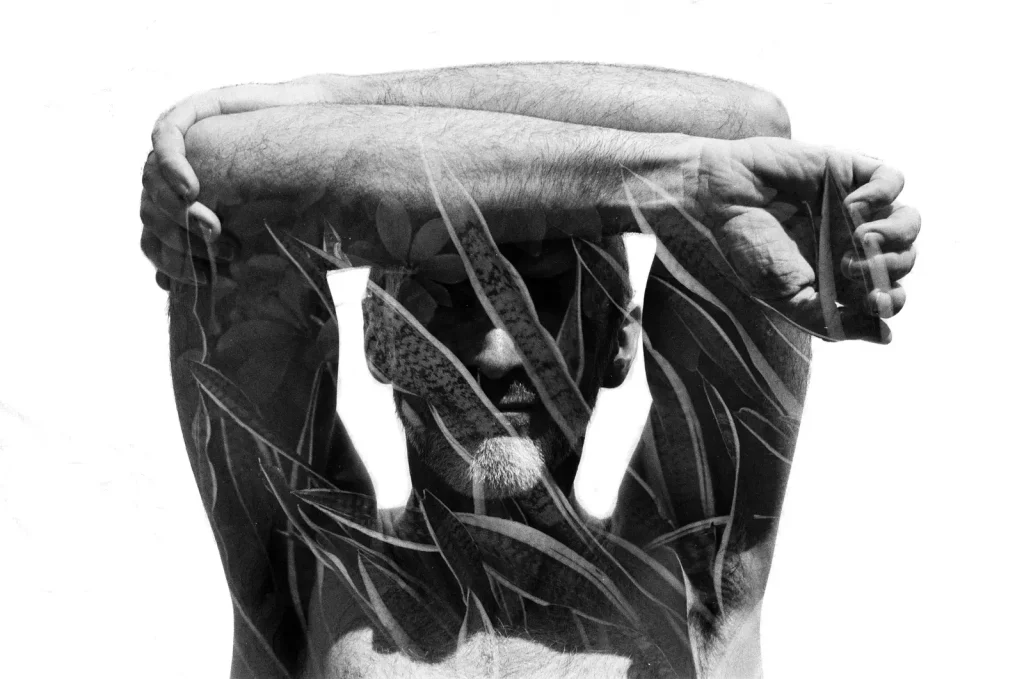
This was the moment where my love of texture and my love of double exposure would come together. I shot a couple of rolls of flora textures in Victoria Park in Hong Kong near where I live, and over the summer I took advantage of a gathering of friends to do a first test shoot. I wanted bare skin so that the textures of clothes would not clash with the flora textures. I was shooting in natural light with a white sheet as a background for separation.
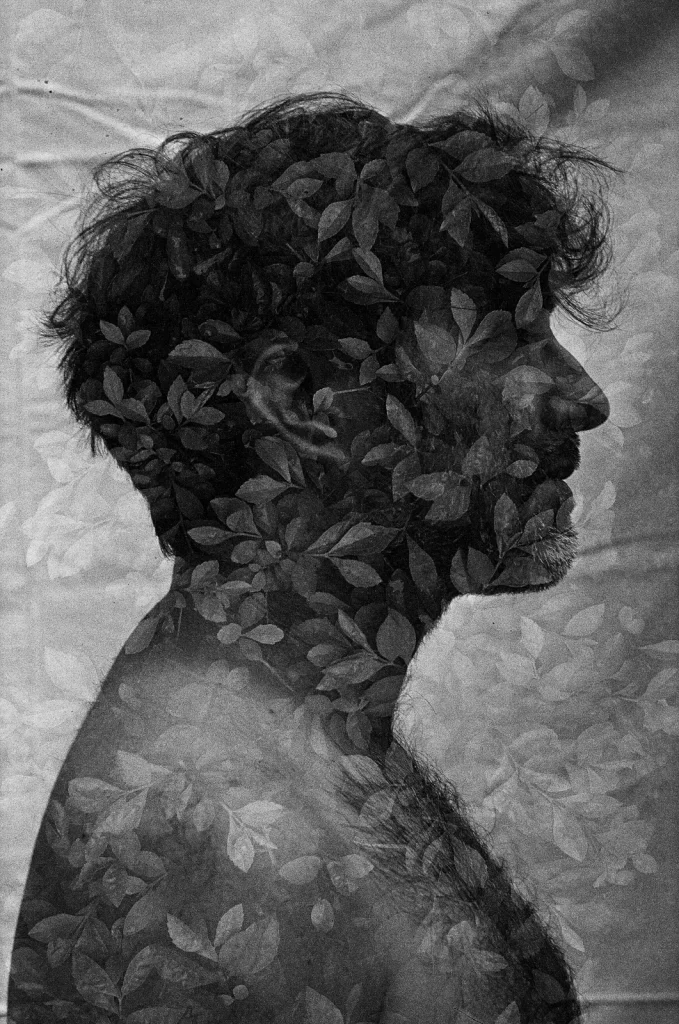
I learned a few things from this first shoot:
– The choice of film was a key factor in the output. The Agfa Scala 200 roll was dark and did not have much separation with the background (the white came out gray). It could have been because the roll was expired, but also possibly because of the limited dynamic range of the slide. The Ilford Pan F worked much more as I expected it to although some of the textures were blurry due to the low ISO on the film.
– Working with natural light didn’t give me much control of the lighting, and I generally had limited shadows in the shots. That means that texture was generally light on the skin and heavy in the hair and occasional shadow areas.
I dubbed this project Human Nature. For the second session, I asked some Brussels based friends who weren’t shy of nudity to come with me for a marathon studio session. I used Ilford FP4+ to minimise grain but hopefully have all my texture shots sharp. I also shot one roll of Kodak Portra 160 and two rolls of Dubble Jelly 200, in order to experiment with colour film.
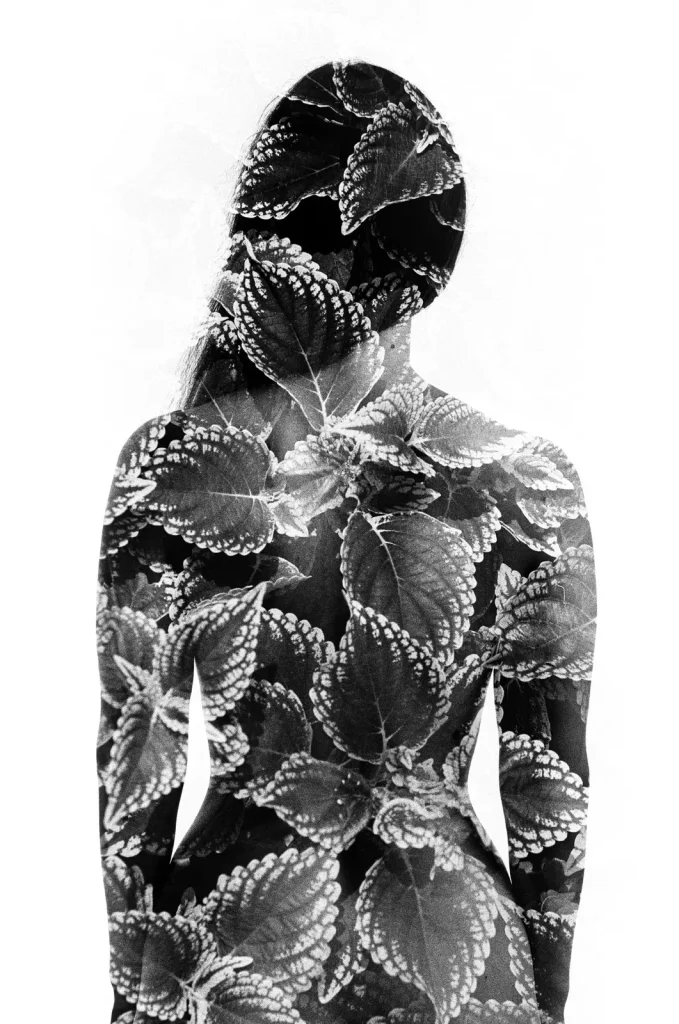
That second session yielded a lot of great results. For a start, with control over the lighting I was able not only to blow my background, but also to contrast the lit areas of portraits and the shadow areas. This allowed me to bring in a lot more apparent texture than in the first series.
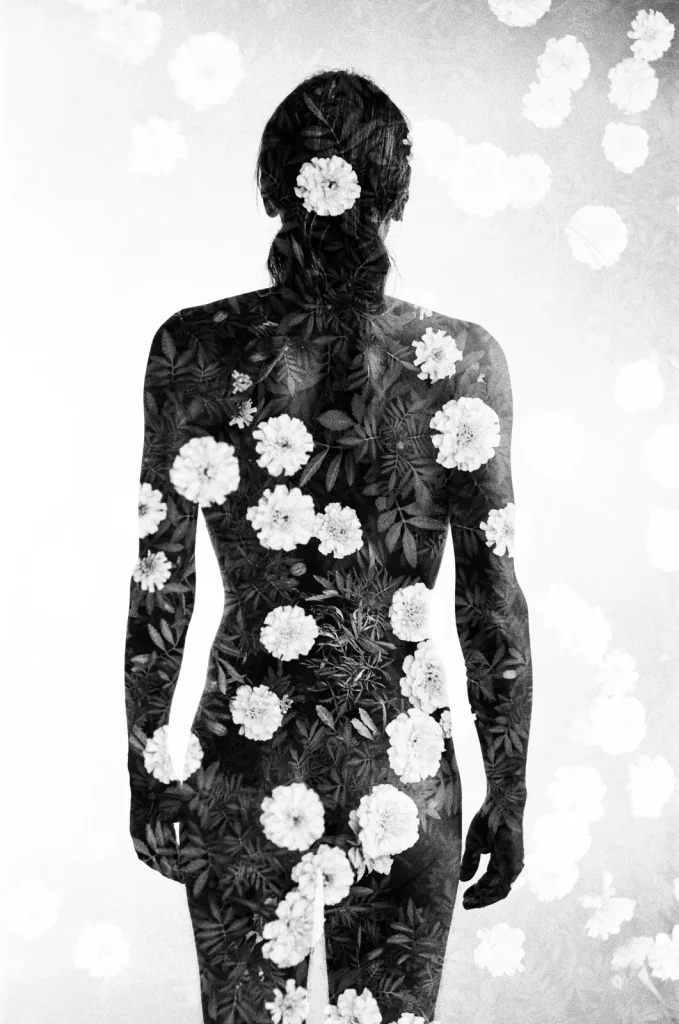
This second session also taught me a few important things about the process:
– While I like (and embrace) the randomness of the process (you never know exactly which texture will show up, some textures clearly don’t work, at least not generically. Very small leaves look like insect swarms which makes for very creepy portraits, like the face is eaten by the texture. Fine if that’s what you’re after but aesthetically iffy. Long leaves are directional (by definition). Sometimes the wrong direction works, sometimes it doesn’t. Large leaves are more hit and miss and would benefit from being shot from further away, although that’s not always possible.
– With control of the light the prevalence of the texture in the shadows is very strong, and while I avoided backlit shots, sometimes you lose too much detail. With back shots especially, I like the idea of still being able to distinguish muscles and other features of the body.
– The colour shots are hit and miss. I’d focused on colourful textures (flowers, mostly), and when they came through they were quite stunning, but most of the colour shots weren’t so good. The Portra worked a lot more consistently than the Dubble, probably because Dubble is already double exposed, causing some image and colour degradation in the process. Incidentally, both rolls of Dubble also had misaligned frames. Not by much, but still. I suspect it’s down to the sturdiness of the film material itself.
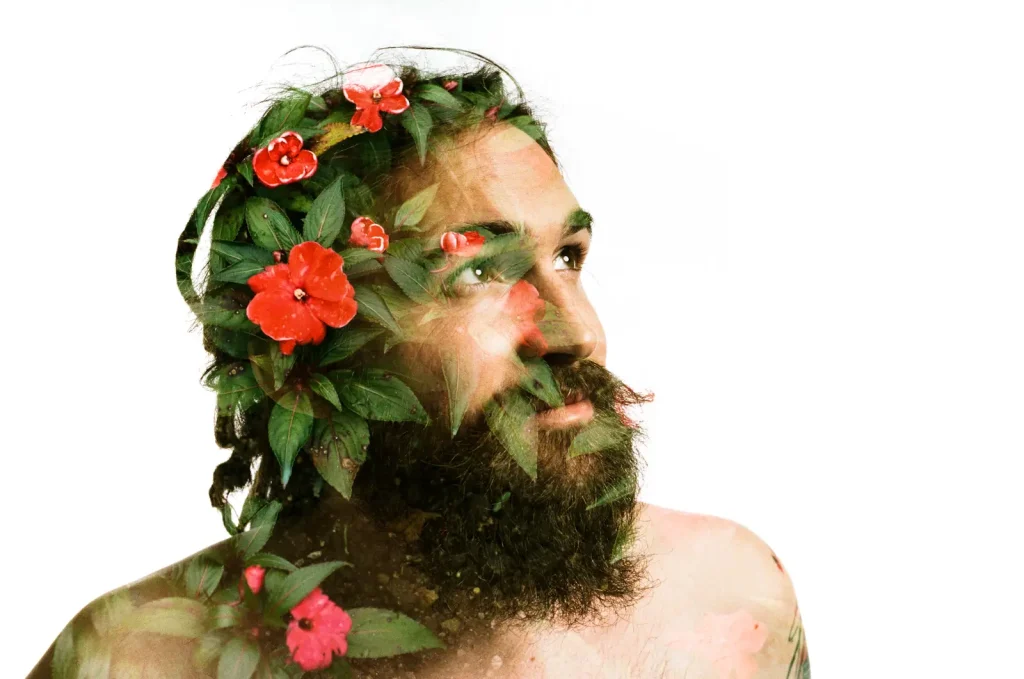
This is a work in progress. I hope it will attract interest at some point maybe to exhibit or do a book or both, but in the meantime I’m starting to plan the next wave of studio sessions. Here are some of the things I intend to try:
– I want to be more consistent in shooting similar types of textures so that while I still won’t know exactly how the double exposure plays out, I will be able to anticipate obvious mismatches that simply will not work. My process for both sessions was to shoot 1/3 or half a roll with the same model and then move on to the next model. Next time I want to have the models rotating much faster so that I do a series of contrasted round leaves, then a series of long leaves, then a series of barks, etc.
– I want to start experimenting with different textures. A couple spring to mind: for colour, I’d like to see how street art and skin work together. For black and white, while I love the organic textures of nature I also want to look into concrete and scrapers for something maybe a bit darker in tone. You can see an example of that here that shows some promise.
– Longer term, I’m seriously considering doing these as large format photography. I’ve never done large format, so there’d be a learning curve for sure, but at least the frame superimposition issue would be solved anyway.
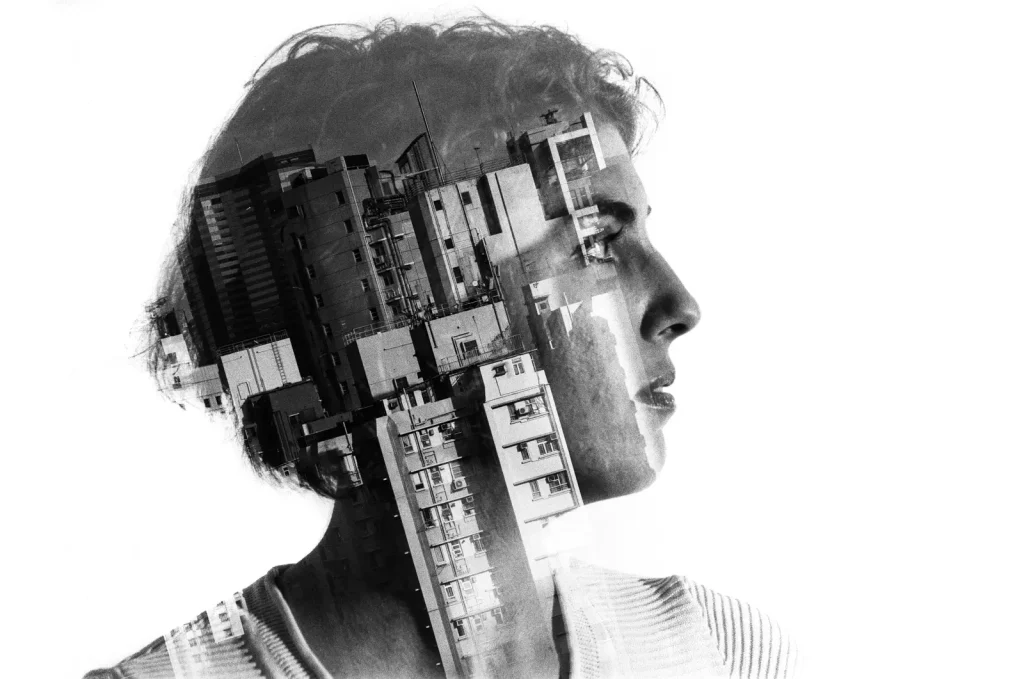
Double exposure on film is nothing new, but digging into the history of it I’ve struggled to find consistent bodies of work. Harry Callahan has done some really interesting stuff using branches and treescapes rather than leaves. Similarly, Finnish artist Christoffer Relander did a landmark series of landscapes in a jar that was film double exposure (he also does digital double exposures with flora textures, although the final result looks very different to my eyes). I plan to do more digging into the history of the process to understand how it may have been used previously.
So anyway, expect to see more in this field from me in the coming months!
If you’re interested in my photography, please follow me on Instagram: @benfelten
Share this post:
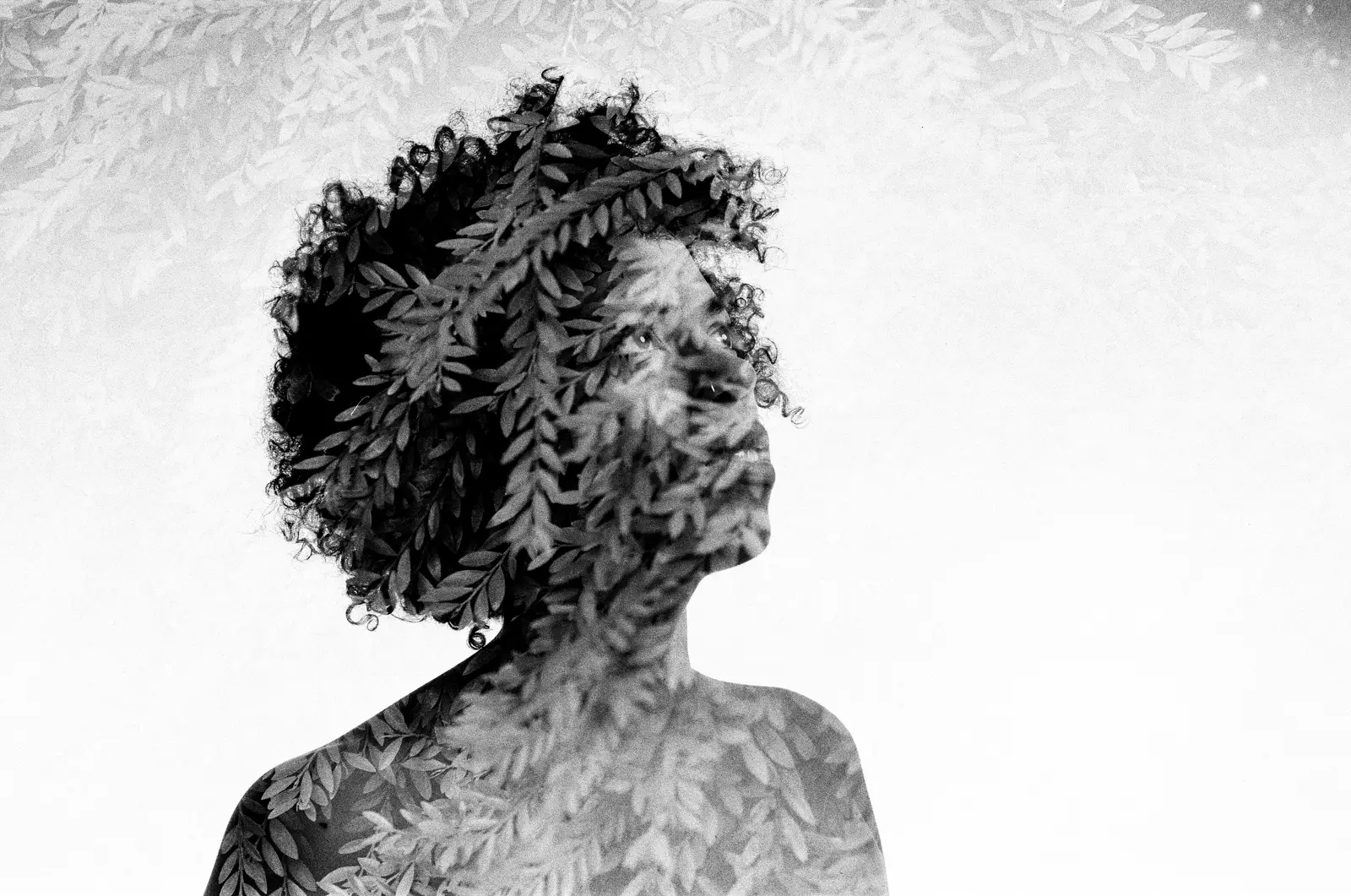








Comments
Terry B on Shooting Textured Double-Exposures with the Hasselblad XPAN – By Benoît Felten
Comment posted: 10/03/2020
The one image that doesn't "gel" for me is the final one. Whereas there is a synergy with the subjects and overlays of the others, for me there is an incongruity with the starkness of the building structures on the woman's face. Each to his own, though.
Comment posted: 10/03/2020
Khurt Williams on Shooting Textured Double-Exposures with the Hasselblad XPAN – By Benoît Felten
Comment posted: 10/03/2020
Comment posted: 10/03/2020
Louis Sousa on Shooting Textured Double-Exposures with the Hasselblad XPAN – By Benoît Felten
Comment posted: 10/03/2020
Comment posted: 10/03/2020
Rock on Shooting Textured Double-Exposures with the Hasselblad XPAN – By Benoît Felten
Comment posted: 10/03/2020
Comment posted: 10/03/2020
Daniel Sigg on Shooting Textured Double-Exposures with the Hasselblad XPAN – By Benoît Felten
Comment posted: 10/03/2020
Comment posted: 10/03/2020
Mike Hannon on Shooting Textured Double-Exposures with the Hasselblad XPAN – By Benoît Felten
Comment posted: 10/03/2020
Incidentally, AFAIK Canon EOS cameras (and probably also many of their point and shoots, I guess) electronically align the frames in the same position every time. Some have custom functions to leave the film leader out after rewind (or you can use a film retriever) so it should be easy to do this technique on 35mm.
Btw, I like the urban pic :)
Comment posted: 10/03/2020
Matthias on Shooting Textured Double-Exposures with the Hasselblad XPAN – By Benoît Felten
Comment posted: 10/03/2020
Comment posted: 10/03/2020
vicvl on Shooting Textured Double-Exposures with the Hasselblad XPAN – By Benoît Felten
Comment posted: 10/03/2020
Comment posted: 10/03/2020
Graham Orbell on Shooting Textured Double-Exposures with the Hasselblad XPAN – By Benoît Felten
Comment posted: 10/03/2020
With my Rolleicord or my Linhof 4X5 I experimented with night lights using a tripod to take one exposure before it was completely dark and the second exposure on the same frame without moving the camera once the city lights were on.
I look forward to seeing more of your work.
Comment posted: 10/03/2020
Marc Wick on Shooting Textured Double-Exposures with the Hasselblad XPAN – By Benoît Felten
Comment posted: 10/03/2020
Comment posted: 10/03/2020
Aivaras on Shooting Textured Double-Exposures with the Hasselblad XPAN – By Benoît Felten
Comment posted: 11/03/2020
Julian Higgs on Shooting Textured Double-Exposures with the Hasselblad XPAN – By Benoît Felten
Comment posted: 11/03/2020
Comment posted: 11/03/2020
Alex on Shooting Textured Double-Exposures with the Hasselblad XPAN – By Benoît Felten
Comment posted: 11/03/2020
Happy shooting!
Alex on Shooting Textured Double-Exposures with the Hasselblad XPAN – By Benoît Felten
Comment posted: 12/03/2020
Comment posted: 12/03/2020
Chris Pattison on Shooting Textured Double-Exposures with the Hasselblad XPAN – By Benoît Felten
Comment posted: 17/03/2020
About the value of my (and your?) photography - By Benoît Felten - 35mmc on Shooting Textured Double-Exposures with the Hasselblad XPAN – By Benoît Felten
Comment posted: 21/07/2020